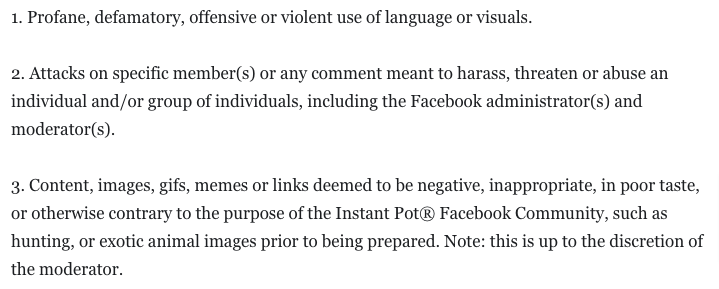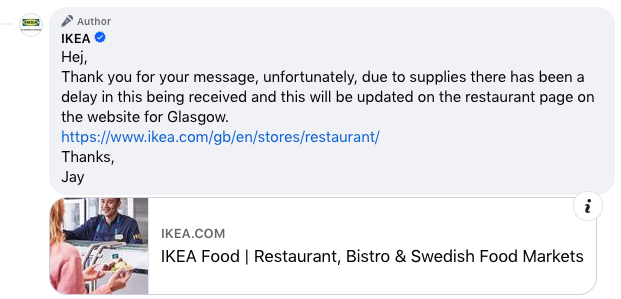Unfortunately, negative comments are a fact of life for any brand with a social media presence because you can’t please everyone all the time.
But, because we’re naturally optimistic people, we prefer to see it as an opportunity: handle those comments effectively, and your audience could even end up liking you more. In fact, 83% of customers say they feel more loyal to brands that respond to and resolve their complaints.
Read on for our top tips on navigating negativity on social media.
1. Share Behavior Guidelines for Your Followers
Some negative comments require a response from your brand.
Others, however, are designed to offend for no good reason. Rather than replying to these online trolls, your best bet is to block them and move on — they’re not the type of people you want to be engaging.
But how do you sort the “bad actors” from the legit customers simply having a bad day?
Your best bet is to draw up guidelines for how you expect your audience to behave. Let them know that you won’t tolerate anyone abusing your social media team, attacking your followers, or using inappropriate or hateful language. And, of course, don’t forget to share those guidelines via a pinned post or your social media bio.
For example, Instant Pot has published rules for anyone planning to join its 3.2 million-strong Facebook Group, the Instant Pot Community.
It includes easy-to-understand guidelines around what is (and isn’t) acceptable and clarifies that people breaching these guidelines will have their posts removed and their profiles blocked.

This ensures the Instant Pot team doesn’t waste time and emotional energy negotiating with trolls, freeing them to focus on genuine customer complaints.
2. Respond To All Customer Complaints
Dealing with complaints is a key factor in the life of any social media professional.
Sure, it might not be the most fun part of the job, but it’s a crucial element of customer support. As we’ve already noted, when you get it right, you can turn dissatisfied customers into happy ones — but if you ignore them, you leave yourself open to negative reviews. This is a big problem given that 98% of consumers say reviews are an “essential resource” for informing their purchase decisions.

Unless you can deal with a complaint in a single reply (unlikely), your goal should generally be to shift the conversation toward a non-public-facing channel — like email, live chat, or your social media inbox.
GEICO got it right here by sympathizing with the customer, then urging them to follow up by providing more specific information via DM:
Hi, I’m sorry for the difficulty with your policy. Please DM us your policy number, state, and full name, so I can get you connected with an agent.
-Liz— GEICO Service Team (@GEICO_Service) February 18, 2024
That way, they can discuss the matter privately while also making it clear to the rest of their audience that they’re dealing with the problem.
3. Use Social Media Monitoring To Find Non-Mentions
Frustratingly, not all unhappy customers will speak to you directly via your mentions.
Some will simply sound off about you without tagging you in the post. Or they might intend to “@” you but misspell your brand name. Either way, you could receive a ton of negative publicity without even realizing it.
Fortunately, there’s a solution: social media monitoring.
Tools like Hootsuite and Sprout Social can crawl multiple social platforms, seek out untagged mentions of your brand, and even analyze the sentiment behind each post. That way, if someone is making a fuss about your organization, you can respond before the matter gets out of hand.
4. Create Templated Responses
Speed is of the essence when answering negative comments, with 44% of US consumers — and 46% of consumers globally — expecting to receive a response to social media questions or complaints within an hour.

That’s a tough task.
But it gets (a little) easier if your social media team can lean on a bunch of templated responses to frequently asked questions.
Follow these best practices when creating your templates:
- Identify common questions: Understand the types of queries you receive most often by speaking to your sales team, account managers, and customer support agents and analyzing your website’s live chat logs.
- Consider negative scenarios: Think about potential customer issues that might crop up down the line. For instance, if you’re launching a new product and expect demand to be high, you might face a lot of questions about stock availability.
- Keep responses up to date: Once you’ve crafted a bunch of templated replies to common questions, schedule time to update your responses so they don’t get stale. You don’t want customers to feel like they’re receiving a stock message.
5. Provide a Personalized Response
Boilerplate replies will only get you so far. Customers with complaints want to feel like you’re taking them seriously, not trying to silence them with generic platitudes.
At the very minimum, you should be referring to them by name — provided you know their name from their social media presence.
Ideally, take things a step further by personalizing specific elements of your response based on the customer’s message, just like in this example from Nike:
Hey there! It looks like those are an older style of ours, but we’d be happy to send over some recommendations! Meet us in DM with your location and what size you’re after, and we’ll go from there. https://t.co/klmMF0Q8Tn
— Nike (@Nike) January 21, 2024
Essentially, this response still says: “DM us more information.” But Nike specifically references the customer’s issue and offers recommendations, so it all feels more personal.
6. Use the BIFF Framework
When writing responses to negative social media messages, one effective approach is to use the BIFF framework.
BIFF stands for “Brief, Informative, Friendly, Firm.” Here’s how it applies to handling complaints:
- Brief: Keeping your replies short and to the point will reduce the chances of starting a prolonged, back-and-forth dialog full of angry messages.
- Informative: Concentrate on making accurate, factual statements — and avoid making sarcastic or negative comments yourself.
- Friendly: The more personable you are, the more likely the customer will respond in a friendly — or at least neutral — manner. Remember: you catch more flies with honey than vinegar!
- Firm: Set out your organization’s position in a clear, non-aggressive manner. Again, being firm and factual makes it less likely that you’ll end up in a long, drawn-out conversation.
7. Avoid Overpromising
The simplest way to deal with negative comments on social media is to simply give the customer what they want. They spilled Diet Coke on their new laptop, and now they’re unhappy it wasn’t waterproof. Send them a new one — problem solved!
Of course, this approach has an obvious downside: it sets a precedent, which means you’ll likely have to give other dissatisfied customers the same over-generous offer in the future.
So rather than promising to do whatever the customer demands simply because they’re unhappy, take the time to understand their complaint — then explain how you can fix it in line with your standard policies.
For instance, in this example, Amazon was confronted by a customer who was upset at not being able to claim a special offer:
Please be informed that when the promotions are available for the product, you can place a new order using the promotion.
-Juhi— Amazon Help (@AmazonHelp) February 19, 2024
No doubt it would have been quicker and simpler just to give the customer the discount again — but that would open up a whole can of worms. Instead, Amazon’s support agent stood firm and clearly explained the company’s policy.
8. Apologize When Necessary
Dealing with negative comments on social media is often about placating customers and being empathetic without accepting that the brand did anything wrong.
That’s hardly surprising in a world where admitting liability could open you up to legal action.
But sometimes, a simple apology is the only correct response.
Want an example? We’ll need to start by providing some context:
If you’ve spent enough time on X/Twitter, you’ll likely have encountered the Gender Pay Gap Bot, which calls out organizations for failing to back up their words around equality and inclusivity with action.
The bot responded to an International Women’s Day campaign from Imperial College London (ICL) — one of the UK’s most prestigious higher education institutions — by pointing out that the college pays women less than men on average.
That’s the recipe for a PR nightmare, right?
However, ICL handled the negative comment well by accepting its failings, promising to do better, and — most importantly — sharing information about its efforts to close the pay gap:
Thanks Gender Pay Gap Bot, you’re right and we agree this isn’t good enough.
We’re working to address this and to eliminate our ethnicity pay gap too. There’s more information about our work here: https://t.co/2FuGLrfQRy
We’ve still got a lot of work to do.
— Imperial College London (@imperialcollege) March 8, 2022
9. Be Transparent
Saying “no” to customers is never easy. But it gets easier if you can back up your response with a transparent explanation.
Sure, it might not turn the unhappy customer’s frown upside down. Still, it will at least let other people in your audience know that this isn’t just some arbitrary decision: you explored the cause of the problem, did your best to solve it, and communicated everything that happened.
For instance, IKEA sent this response to a customer who was unhappy they couldn’t order a specific dish at one of its in-store restaurants:

The support agent can’t magically fix the issue in a scenario like this — but they can provide valuable extra context.
10. Thank Customers for Their Feedback
While your life would be a lot easier if customers never complained, the fact is that each negative comment you receive is an opportunity to improve your brand’s product or service.
Because if one customer experiences an issue, it’s a safe bet that others will, too. The sooner you know about it, the sooner you can resolve it.
As such, it pays to thank customers for taking the time to get in touch and point out the problem they’re facing. Tell them you appreciate their feedback, you’ll try your hardest to fix it, and you’ll share the outcome with them.
That’s how you turn angry customers into loyal brand advocates.
Want to learn more about how to build an engaged brand community through social media? Sign up for one of our upcoming social media conferences.
Featured image by Freepik.









